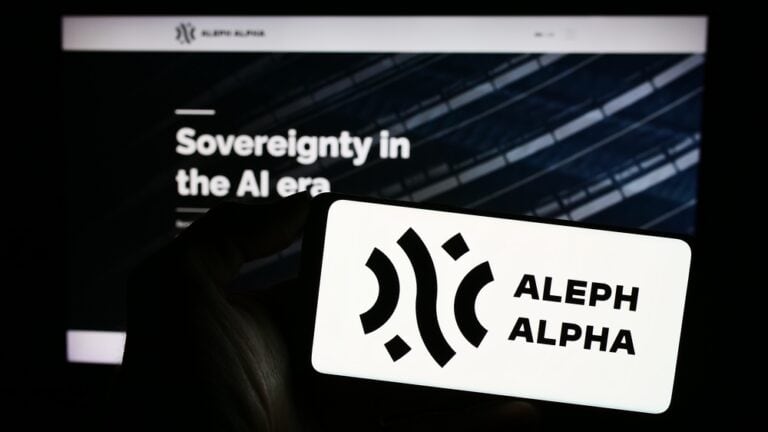Aleph Alpha is releasing two open-source models fully compliant with the European AI Act. The German start-up’s models are clearly aimed at European enterprises and demonstrate the feasibility of the new AI Act.
Aleph Alpha’s new offering consists of two large language models (LLMs) of similar size: seven billion parameters. The new family was named Pharia and consists of the standard Pharia-1-LLM-7B control model and the “aligned” version of the same model. The latter version should be a more reliable variant as a result of additional training, so there should be fewer biases and unreliable or spurious output.
Counterbalance to American AI dominance
Aleph Alpha’s new offering is important for three reasons. We will discuss those reasons in more detail, but in general, it validates the European AI Act and fuels new debate within the open-source world.
Aleph Alpha’s two newest models assure European companies of continuity under the European AI Act, the two LLMs are already 100 percent compliant with the legislation from launch. It is wise of Aleph Alpha to focus entirely on the European market in its approach. Well-known competitors in the AI landscape tend to be of American origin.
Because of the company’s German origin, Aleph Alpha has a greater focus on the European market. This is clearly reflected in the availability of several European languages for the LLMs to work with. The models are culturally and linguistically optimized for German, French, and Spanish.
Good news for open-source
At the same time, the launch is again a counter-attack to models whose source code remains secret. This is the case with OpenAI-LLMs, Google’s Gemini, and Anthropic’s Claude, for example. Open-source models are generally expected to have lower performance than their closed counterparts. Meta has proven in the past that this assumption is not always true.
Initial tests of Pharia shared on Hugging Face show that Pharia performs less well than the Meta model Llama-3.1-8B-instruct. However, Pharia excels in specialized tasks where control over model output is paramount. Moreover, Meta’s model consists of slightly more parameters and is trained on relatively recent information in the AI world, as the model became available about a month before Pharia. Llama-3.1 could, therefore, gain a competitive advantage from the greater number of parameters it can throw into the fray.
Debate over open-source AI and Europe
Finally, the release clearly counters the concerns recently shared by the CEOs of Meta and Spotify. In it, Mark Zuckerberg and Daniel Ek accuse Europe of killing innovation with open-source AI models through overly strict regulation. At Meta, these concerns are holding back the launch of Llama models in Europe. “This prevents European organizations from accessing the latest open-source technology.”
This comment can be minimized because it comes from U.S.-based Meta, which is why the presence of Spotify CEO, a Swedish company, is so important. Ek is not really concerned about the complications of the AI Act for his own company in that it has enough knowledge in-house due to early investments in AI. He does express concerns for start-ups that Ek says will get lost in complex regulations, preventing them from growing.
According to Zuckerberg and Ek, open-source AI models give Europe the potential to foster innovation, collaboration, and economic growth. In turn, Pharia’s release brings down the CEOs’ entire argument. The open-source model is available in Europe, complies with the AI Act and also comes from a start-up. The success of the models and the company just have to prove themselves before we can completely forget about the CEOs’ concerns.
Also read: Llama 3.1 is the largest model: turning point in open source AI?
Partnership with HPE
Aleph Alpha’s new offering has several strengths that challenge OpenAI, Google, and Meta, among others. To turn it from potential to success, it still needs traction with the market. For that, the partnership with HPE could be an important driver. Through HPE GreenLake for Large Language Models, organizations get the right resources to get started with LLMs. Since Aleph Alpha’s open-source model Luminous was already available on this offering, it’s only a matter of time before Pharia is available for use.
Also read: HPE enters AI market with HPE GreenLake for Large Language Models
For organizations, the choice between the two models, the standard or the “aligned” version, is normally simple: why choose a less reliable option when it consumes the same amount of resources? The release of the standard version is aimed at researchers. Research into the potential hazards and risks of an LLM is a requirement under the AI Act. The legislation should guarantee that models do not become a “black box” into which data is fed and, after an unclear process, give an unpredictable output. Those who do not belong to that target group do in fact only need to know about the ‘aligned’ version.
A warm welcome, Pharia
Aleph Alpha thus immediately cuts across several topical topics with the launch of Pharia. Other open-source models have shown in the past that there is no reason in the AI world to keep everything closed-source. Pharia adds another unique dimension by being fully in line with the European AI Act. This recent legislation is still raising a lot of dust within the AI world, which is mainly dominated by U.S. players. (Counter)wind from a European player may, therefore, be very warmly welcomed.
For the European alternative, the French Mistral AI was suggested earlier. Within the AI Act, however, the story of Aleph Alpha is more interesting. Within that legislation, Mistral AI has worked itself into a difficult position. It argued hard for milder regulation for European start-ups, and just after that was heeded, it struck a deal with U.S.-based Microsoft. That made MPs feel played, on the one hand, and American interference in a European company, on the other.
